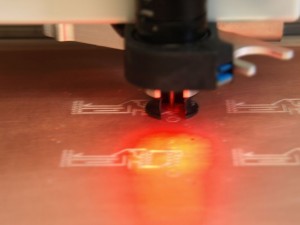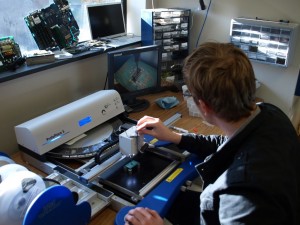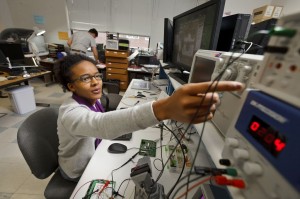Computer Engineering Lab
The Computer Engineering Lab (MCT163) supports the Department’s computer engineering activities. There are four major components to the lab. The Fabrication Line, the Testing & Development Stations, the Reference Board Library, and the 3D printing resources. The lab is open for general use during normal academic hours. Faculty coordinate 24×7 access for students who need access to the lab to complete projects.
Fabrication Line

Our students use the equipment in this part of the lab to fabricate custom circuit boards. Students get hands-on experience with the fabrication processing, going from blank copper plate to completed circuit board. The majority of the equipment was purchased from LPKF, Inc, and was selected because it is the state of the art in mechanical circuit structuring, and is largely chemical free; which is important for student safety and reducing the environmental footprint of the process.
LPKF Protomat S-63 Milling Machine
Mill custom circuit boards from copper plated FR4. Feature sizes down to 4 mil (.1mm). Also allows computer aided drilling and contour routing of various materials and 2.5D manufacturing.
LPKF ProtoPress Board Press
Create multi-layer PCB (up to 8 layers)
LPKF ProtoFlow Reflow Oven
Coating cure and reflow soldering
LPKF MiniContact RS Electroplater
Through-hole electroplating

LPKF ProtoPlace
Semi-automatic Pick and Place machine allows accurate placement of parts on a circuit board.
Advanced Techniques AT-GDP1 BGA Rework Station
Stereoscopic microscope and integrated heaters facilitate accurate placement of BGA, QFN, and other parts.
LPKF ProtoPrint
Solder paste stencil mask & application
JBC Tools Hot-Air / Digital Soldering Stations
Part installation & removal, board rework & repair
Targano Trend Digital Inspection Stations
Full HD Digital microscope with auto-focus provides up to 52x magnification to inspect and replace modern small surface mount components
Parts Library
Extensive array of components for students to use on projects. Parts library includes wide array of new parts, as well as a collection of boards students can use for salvage and to study existing system boards.
Testing and Development Stations

There are ten stations dedicated to support testing boards and developing the firmware and device software. These stations include:
- Custom built workstations equipped with:
- Ryzen 7 3700X CPUs
- 32GB System Memory
- 6GB NVidia GTX 1060 Graphics
- Rigol DP832 Programmable DC power supply
- Rigol DM3058E 5.5 digit bench multimeter
- Rigol DS1104Z Plus O2024 16-digital, 4-analog 100MHz scope, w/ 2 CH wave generator
- PIC ICD3 programmer / debugger
- Spectrum Digital XDS510 JTAG emulator
We also provide access to some of the most powerful engineering design and development tools, including:
- Cadence Allegro & OrCAD Schematic Capture & PCB Layout
- Xilinx Vitis, Vivado, ISE, EDK, and System Generator
- Microchip MPLAB X
- National Instruments LabView / Tektronix ed.
- MATLAB with Simulink and the complete set of toolboxes
Our licensing agreements allows the software to be installed on all of our departmental machines, and some of the software can be installed on students’ personal machines.
Reference Board Library
- Xilinx / Digilent ZedBoard Zynq-7000 ARM/FPGA SoC Development Board (see our FPGA wiki and Dr. Briggs’s FPGA videos)
- Basys MX3 MCU Trainer microcontroller boards
- ChipKIT™ PRO MX4 microcontroller boards
- TI Launchpad Tiva C Development kits
- Collection of assorting PMods (Bluetooth, RF, WiFi, Rotary Encoders, 5MP Cameras, and more…)
- Programmers / software development tools for our boards
3D Modelling and Printing Resources
To provide students with the resources to model and fabricate everything from board enclosures to robot parts, we have a number of software and printer options. Both Solidworks and Autodesk Inventor are available for students to design their 3D models. Once designed, we have the following printers to provide a number of various fabrication options.
- Flashforge Dreamer: A dual extruder filament printer capable of two color printing using either ABS or PLA.
- Formlabs Form 2: An SLA (Stereolithography) printer capable of printing with extreme accuracy. Resin options range from various draft grade resins, to high temperature and flexible resins, to bio-compatible resins.
- Formlabs Fuse 1: An SLS (Selective Laser Sintering) printer capable of small scale manufacturing and and prototyping using Nylon 12. This method is more cost effective than SLA as the unfused power provides the support structure while printing parts. In addition, the unfused powder is reclaimed during the post-production process and can be used for future prints.